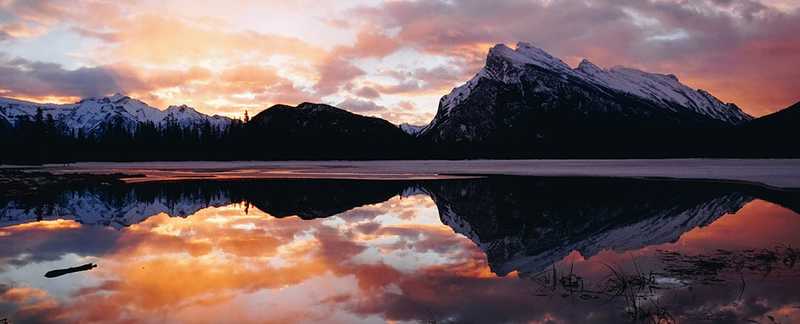Parks In Canada


Canada’s natural splendor boasts incredible scale and variety and promises some of the world’s most impressive visual experiences. The North American country’s natural beauty hardly needs any introduction. However, if you are travelling here, the best way to make the most of your adventure would be to acquaint yourself with the Parks in Canada. Therefore, in this blog, it is my mission to introduce you to some of the most famous Canadian Parks. I will tell you about their locations, the most prominent attractions and the best times to visit. Also, I will give you a few tips and tricks to keep in mind when visiting parks in Canada.
Canada has 47 national parks and reserves. I have chosen a few of my favourites ranging from the most popular to some of the lesser known parks.
Banff National Park in Canada
UNESCO World Heritage Site Offers Diversity and Beauty
My parents raised me with the ethics of “respecting your elders.” For this reason, I just had to start by including the oldest and one of the alluring and undisputed popular parks in Canada, Banff. Banff National Park is the flagship of the Canadian Nation’s Park system. This Park is also known as the Rocky Mountain park and receives over three million visitors per year! Banff National Park is a picturesque park surrounded by majestic mountains, forests and turquoise lakes.

History and Location
This visually attractive park was established in 1885. Banff National Park is situated in the Rocky Mountains in the province of Alberta. The Park consists of an area of 6641 square kilometres (2564 square miles)
More About Banff National Park:
Banff National Park connects to various other parks, most notably, Jasper National Park. Furthermore, the park connects with Yoho and Kootenay National Parks. The connecting points is a real bonus for travellers. For this reason, I recommend that you start your Canadian Park journey in Banff National park.
Banff has more than enough to keep you enthralled for the duration of your Canadian visit. Let’s look at some of the activities that this beautiful park offers.
Activities to do in Banff National Park:
- Wildlife Viewing
- Canoeing
- Downhill skiing
- Ice Climbing
- Ski Touring
- Backpacking
- Canoeing
- Photography
- Cross Country Skiing
- Geocaching
- Scuba Diving and Swimming
This charming Park offers mountains, various glaciers, forests, ice fields, lakes and alpine landscapes. It might take you a lifetime to discover all the wonders of this park! Put this one at the top of your bucket list!

Additional Attractions of Banff National Park
Convincing someone that Banff is a must-see park in Canada is not a difficult task at all. I mean, a simple Google Images search would get the job done and dusted within seconds. Who wouldn’t want to feast their eyes on that beauty in person? With this in mind, what are some of the most notable spots in Banff?
Firstly, one of my favorite destinations in Banff National Park is Lake Louise. Lake Louise is a turquoise, glacier-fed lake. Stately mountain peaks forms and enthralling edging around the lake. And to top it off you will find Château Lake Louise overlooking the lake.
This stunning part of the park offers visitors with the joys of summer and winter activities alike. The town of Hamlet provides a tad of civilisation and luxury within one of the most breathtaking parts of the park.
Banff further spoils with the beauty of Moraine Lake (definitely an Instagrammer’s dream) and Peyto Lake. Besides, you can also satisfy your need for relaxation at the charming Fairmont Banff Springs Hotel.
Best Times to Visit Banff National Park:
The best times to visit, according to Google popularity statistics would be from June through to September, with August as the most popular month. If you are looking for all weather attractions in Banff National Park, click here.

Jasper National Park
Any blog discussing parks in Canada has to include the biggest National Park in Canada namely, Jasper.
History and Location
The Jasper National Park has 11,000 square kilometers (4200 square miles) of icefields, hot springs, lakes, waterfalls and mountains, all with their own unique allure. Jasper is situated in the beautiful province of Alberta and was declared a park in 1930. The park offers visitors with the opportunity to explore a more rugged and untamed part of the Alberta landscape.

Activities and Attractions in Jasper National Park
Similarly, to Banff, Jasper National Park offers an opportunity to enjoy activities in both summer and winter.
Summertime Activities:
During the summertime, I recommend hikes and photo missions. Put on your walking shoes, take your camera and explore the mountains, lakes and valleys in this fantastic park.
- Mount Edith Cavell,
- Pyramid Lake,
- Maligne Lake
- Medicine Lake
- Tonquin Valley
Wintertime Activities:
In winter you can enjoy the slopes of Marmot Basin for an enthralling ski experience.
- Alternatively, you could opt for one of the following activities:
- Ice Skating
- Dog Sledding
- Cross-Country Skiing
- Fat Baking
- Ice Climbing
The park also offers a host of recreational activities such as:
- Camping
- Fishing
- Kayaking
- Rafting
- Hiking
Wildlife and Birdlife
Jasper National Park has a wide range of wildlife and birds. If you are a lover of wild animals you would expect to see one or more of the following animals:
- Moose
- Elk
- Porcupines
- Beavers
- Wolves
- Grizzly Bears
Lastly, you can also enjoy the spoils of hot springs at the entrance of the Park. If you are interested in finding out about even more things to do, click here.
Best Times to Visit Jasper National Park
According to Google statistics, the most popular months in Jasper National Park are June to September, with July and August being the favourites.

Yoho National Park
Awe and Wonder! Entertains the Avid Hiker! Put this one on your bucket list!
Yoho offers visitors stunning mountain ranges and vast lakes surrounded by extensive forests and intriguing ice fields. It is the smallest out of the four contiguous parks – Banff, Jasper and Kootenay. If you are an avid hiker, with a passion for majestic mountains, this is a Park to visit. The Yoho National park is home to 12 mountain ranges! Yoho National Park is a picture-perfect Park. The scenery, majestic mountains and waterfalls will leave you in awe!
History and Location Yoho National Park
Yoho National Park in Canada is one of the oldest Parks in the country.
Yoho was declared a park in October 1886, and the park is situated in the Rocky Mountains in eastern British Columbia, Canada. The park is bordered by Kootenay National Park on the southern side and Banff National Park on the Eastern side. Yoho means awe and wonder. That is indeed what you will experience if you visit this lovely park.

Attractions and Activities in Yoho National Park
Yoho National Park focuses more on entertaining avid hikers and explorers, as opposed to some of the recreational activities found in the other parks.
A few must-see locations:
Wapta Falls
The breathtaking Wapta Falls is the largest waterfall of the Kicking Horse River. The waterfall is about 30 metres high and 150 metres wide. You can enjoy hiking and camping at this majestic waterfall.
Takakkaw Falls
The Takakkaw Falls has a majestic fall of 258m. You could easily drive to the falls on a well-signposted road. After this, you could do a mostly paved walk up to the waterfall. Takakkaw Falls is a trendy destination.
The most popular months to visit Yoho National Park is from June to September. If you are eager to learn about more things to do when visiting Yoho, click here.
Wapta icefield also offers a stunning hike with a view that will leave you breathless.
Activities
- Canoe around Emerald Lake
- Scenic drives and Hikes to Wapta Falls
- Paddle on the Beaver River
- Hike up Yukness Ledges, View Lake O’Hara Alpine Circuit
Kluane National Park and Reserve
Wilderness of Icefields, Towering Peaks and Mountains, Forests, Towering Mountains
If adventure and ruggedness are what you seek, Kluane National Park is the perfect reserve for you! This is a gorgeous resort! Emerald forests form the backdrop of picture-perfect turquoise lakes. To add another dimension of beauty, you will experience the majestic mountains and wilderness of icefield! This is the park that dreams are made of!

History and Location
Established in 1972, Kluane is one of the colder and drier of the Canadian parks. It stretches for a whopping 22,013 square kilometres. The Park is situated South West of the Yukon – near the Alaskan border.
Majestic towering mountains dominate the Kluane National Park. So, if you enjoy mountain scenes and activities, this is the park for you! 83% of the park consists of imposing mountains. The park also has the highest peak in all of Canada. Mount Logan is 5,959 meters or 19,551 feet tall. Additionally, the park has ice fields and glaciers. The
Furthermore, the park contains many mammal species, from small to large. North America’s largest grizzly population lives in this park. Lastly, the park boasts with about 100 bird species. So, if you are a keen birdwatcher, be sure to take your bird watching equipment along!
Activities in Kluane National Park
Hiking and Mountain Climbing is one of the most popular activities in Kluane. You could hike on trials such as St. Elias Lake, Mush Lake Road, Shorty Creek and many more.
If you are a rock climber, this is the Park for you! As mountain climbing is very popular in this park. It is well worthwhile to mention that Mt. Logan is the biggest challenge to overcome. The overall ascent and descent of Mt Logan takes around three weeks and, although it is not considered very technical, (from mountaineering perspective), extremely harsh temperatures will make the journey extremely challenging.
- A few other activities:
- River Rafting Expeditions on the Alsek River
- Mountain Biking on abandoned mining roads.
- Horse riding through the Alsek pass
- Boating and fishing on the many lakes in the park

Best Times To Visit Kluane National Park
September is the most popular month, with July, October and November also attracting a reasonable amount of visitors.
Quick Inclusions
I hope this blog has given you great insight into the seemingly endless scale of Canda’s National parks. For you to have a few more options to plan for, I am ending the blog with quicker inclusions.
Bruce Peninsula National Park
This park is located on the Bruce Peninsula in Ontario and ranges over 156 square kilometres. Although the park is a mere fraction in size compared to those mentioned above, it is one of the largest protected areas in Ontario.
Activities Bruce Peninsula National Park
- Hiking
- Camping
- Bird Watching
You can enjoy many exciting activities such as hiking, camping and bird watching. Visitors can also enjoy vistas from which to enjoy either sunrise or sunset. Beautiful cliffs and an array of smaller mammals as well as black bears offer further enthrallment to those who choose to visit Bruce Peninsula National Park.
Best Times to Visit Bruce Peninsula National Park
The most popular visiting times are from June to September. For a more extended list of things to do in Bruce Peninsula National Park, visit this page

Wood Buffalo National Park
Established in 1922, Wood Buffalo National Park stretches through northeastern Alberta as well as the southern Northwest Territories. At 44,807 square kilometres, it is also the largest national park in Canada. The park offers visitors with the opportunity of visiting the world’s largest dam as well as seeing the world’s largest herd of free-roaming bison. The park also provides visitors with many trails and camps that promise many animal sightings, ranging from black bears and timber wolves to snowy owls and the endangered Whooping cranes. Because of the park’s sheer scale, there are many more things to do and spots to see. For a more detailed list, click here.

Prince Edward Island National Park
The Prince Edward Island National Park is one of the smallest and lesser known parks in Canada. Although the island is quite large, the national park is only 27 square kilometres big. Sadly, due to human impact, it is also the most endangered of the 47 parks and reserves in Canada. Visitors can enjoy the park’s offer of beaches, wildlife watching, as well as camping. Warmer summer months are the most popular, meaning you should plan your trip for July – August.

Parks In Canada – Conclusion
I hope this blog has given you great insight into the seemingly endless scale of parks in Canada. There really is no end to the beauty. If you are unsure of how to go about visiting Canada to experience the natural wonder, Canada Abroad can help you. See how we can help you visit Canada – here

